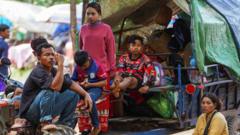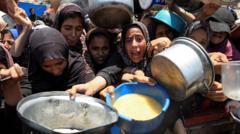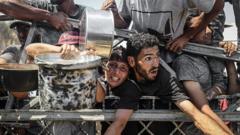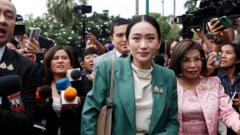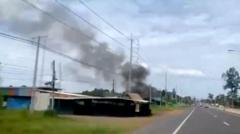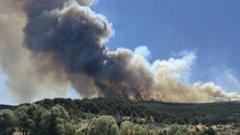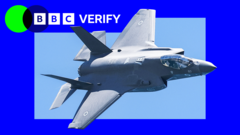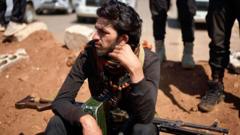The military conflict has roots that trace back over a century, intensified recently by territorial claims and political tensions.
**Border Clashes Between Thailand and Cambodia Leave 12 Dead, Escalate Long-Standing Dispute**
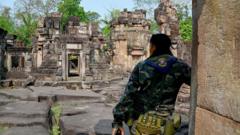
**Border Clashes Between Thailand and Cambodia Leave 12 Dead, Escalate Long-Standing Dispute**
Fighting erupts at the disputed border, resulting in civilian casualties and heightened tensions between the two nations.
The ongoing military clashes between Thailand and Cambodia along their disputed border have resulted in the deaths of at least 12 individuals, primarily civilians. This violent confrontation represents a significant breakdown in relations between the two Southeast Asian neighbors, a dispute that has persisted for over a century.
Thai authorities reported that the majority of casualties originated from three provinces, with 11 civilians—ranging from an eight-year-old to a 15-year-old—alongside one military personnel victim. The severity of the fighting was highlighted early Thursday, when each side accused the other of initiating hostilities, leading to a rapid escalation that involved rocket fire from Cambodia and airstrikes by Thailand targeting Cambodian military sites.
In response to the conflict, Thailand has closed its border with Cambodia, and both nations have urged their citizens near the border to evacuate. Thailand has taken extensive measures to relocate around 40,000 people to safety, while civil unrest spreads in border areas. Local resident Sutian Phiwchan conveyed the dire situation, stating, "[The fighting] is really serious. We're in the middle of evacuating."
While each country cites different accounts of the incident, it has become evident that tensions have heightened significantly since May, following a deadly clash that exacerbated an already stirred political climate. The roots of this complex feud reach back to border demarcations made during the French colonial administration of Cambodia, further ignited in 2008 when Cambodia sought UNESCO recognition for a culturally significant 11th-century temple located in the contested territory.
Over the years, sporadic conflicts have claimed lives on both sides, and in the past two months, mutual restrictions have been imposed, including Cambodia's ban on Thai imports and a reinforced military presence along the border.
Political leaders from both countries addressed the matter, with Thailand’s acting premier Phumtham Wechayachai describing the situation as "delicate," emphasizing the need for international law adherence, while Cambodia's Prime Minister Hun Manet asserted the intent for a peaceful resolution, though noted the government's readiness for armed defense if necessary.
Despite the rapid exchanges of fire, both nations—currently lacking strong leadership—still navigate this precarious confrontation. Their political dynamics reflect broader issues of credibility and nationalistic sentiments, contributing to the fragility of the peace that has historically prevailed between them.
Thai authorities reported that the majority of casualties originated from three provinces, with 11 civilians—ranging from an eight-year-old to a 15-year-old—alongside one military personnel victim. The severity of the fighting was highlighted early Thursday, when each side accused the other of initiating hostilities, leading to a rapid escalation that involved rocket fire from Cambodia and airstrikes by Thailand targeting Cambodian military sites.
In response to the conflict, Thailand has closed its border with Cambodia, and both nations have urged their citizens near the border to evacuate. Thailand has taken extensive measures to relocate around 40,000 people to safety, while civil unrest spreads in border areas. Local resident Sutian Phiwchan conveyed the dire situation, stating, "[The fighting] is really serious. We're in the middle of evacuating."
While each country cites different accounts of the incident, it has become evident that tensions have heightened significantly since May, following a deadly clash that exacerbated an already stirred political climate. The roots of this complex feud reach back to border demarcations made during the French colonial administration of Cambodia, further ignited in 2008 when Cambodia sought UNESCO recognition for a culturally significant 11th-century temple located in the contested territory.
Over the years, sporadic conflicts have claimed lives on both sides, and in the past two months, mutual restrictions have been imposed, including Cambodia's ban on Thai imports and a reinforced military presence along the border.
Political leaders from both countries addressed the matter, with Thailand’s acting premier Phumtham Wechayachai describing the situation as "delicate," emphasizing the need for international law adherence, while Cambodia's Prime Minister Hun Manet asserted the intent for a peaceful resolution, though noted the government's readiness for armed defense if necessary.
Despite the rapid exchanges of fire, both nations—currently lacking strong leadership—still navigate this precarious confrontation. Their political dynamics reflect broader issues of credibility and nationalistic sentiments, contributing to the fragility of the peace that has historically prevailed between them.

